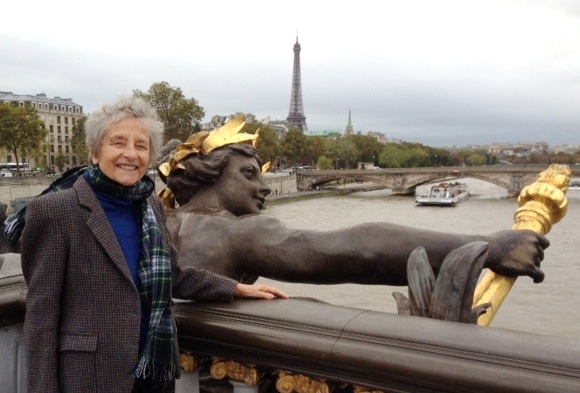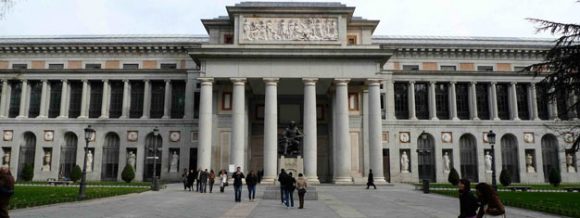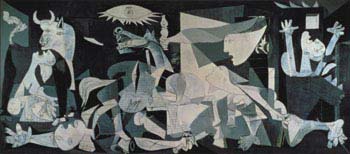
The silent crowd stands with emotion as it would in a cathedral, keeping respectfully a few feet away from “Guernica” – the huge (11 by 27 ft. ) scene painted by Pablo Picasso in 1937 after the bombings by the Nationalist forces led by General Franco of the Basque village of Guernica.
A weekend spent stomping the art collections of Madrid is mind-boggling. Spend six hours a day and you will only have a glimpse at the Thyssen museum, the Prado, the house studio of Sorolla and the Reina Sofia modern art museum.
Baron Hans Heinrich Thyssen-Bornemisza and his son Heinrich had an unusual flair when they selected outstanding works of art in the 1920s and 1930s to create one of the world’s richest private collections at the Thyssen.
Some of the early masterpieces there include, “The portrait of Giovanna degli Albizzi Tornabuoni” (1480), which is a beautiful example of the work of Florence Quattrocento, showing the idealized profile of a woman. “A young man in a landscape” was painted by Vittore Carpaccio, probably from the Venetian school. Nature is codified with each animal having a symbolic meaning related to good and evil.
In his “Jesus among the doctors” (1506), Albrecht Dürer – the most important representative of the German Renaissance – depicts the 12-year-old Jesus surrounded by a group of old men. Some of them have been touched by grace while others have sin written all over their ugly faces, hands like claws threatening the child. In The “Portrait of a lady” (1530?) painted by Hans Baldung Grien – the remarkable disciple of Dürer – the influence of Cranach the Elder is noticeable in the rendering of the decorative elements of the dress, necklaces and large hat with feathers of a supremely elegant model.
Flanders – or modern Belgium and Netherlands – was part of Spain in medieval times and the Prado has many Flemish paintings, which reflect the highly sophisticated culture of trading towns like Ghent or Bruges. Jan van Eyck, Rogier van der Weyden, Gerard David or Hans Memling are the best representatives the 15th century “Northern Renaissance.”
Contacts were frequent between artists who traveled from the “Low Countries” of Northern Europe to Italy. Unlike the Italians who painted with tempura and an egg base applied over a thin layer of wet plaster called “gesso,” Flemish painters used oil directly on panels of wood without knots, such as mahogany or oak.

The “Garden of Delights” by Hieronymous Bosch is one of the highlights of the Prado — it is a display of amusing, bawdy or frightening details intended to give a didactic message to the population of his time. The Flemish landscape painter Joachim Patinir (1480-525) offered panoramic views, with details at some times naturalistic, and at others, fantastic. Instead of using linear perspective, which Florentine artists had mastered at that time, his way of showing distance was by drowning the landscape in bluish colors.
One room of the Prado is turned into a gallery of family portraits of the Spanish dynasty of the Habsburgs. An equestrian painting by Titian of Charles V (1500-1558) at the battle of Mulhberg shows the most powerful sovereign in the world. His kingdom went from the North Sea to the Mediterranean. Velasquez painted many of his descendants: Philip II, Philip III, Philip IV and his son, the young prince Balthazar Carlos, riding a frisky horse. His death, at age 17 from smallpox was a tragedy. And there is poor Charles II, the end of the Habsburg dynasty, who was a total mental and physical disaster because of repeated consanguine marriages.
“Las Meninas” (ladies in waiting), also by Velasquez, is one the most famous paintings ever. It is a complex composition, which has puzzled art historians through the centuries. At the center stands the five-year-old infanta Margareta Teresa, Philip IV’s daughter. Velasquez is looking at us and working on a huge painting, which he never painted. The infanta’s parents are not far away and we see their reflection in a mirror. There are two sources of light, which is quite unusual. In 1957, inspired by the masters of the past, Picasso tackled the deconstruction of “Las Meninas,” particularly of the dog.
Velasquez (1599-1660) was the leading painter of the Spanish “Golden Age,” during the Baroque age which lasted until 1690. As a court painter, he had an immense influence living and working in the el-Escorial palace and was not only honored as an artist but also as the curator of the Kings’ art collections.
The love for animals is strong in Spanish painting. Just two examples: “Agnus Dei”, by Zurbaran (1640) showing a lamb with its four legs garroted is probably the most heartbreaking sight in the Prado, with the animal accepting his fate. The other one is a dog by Goya. In an undefined brownish background of sand and sky, a dog is looking in panic at his master as he is being pulled down by quicksand.
It was not until 1840 that Spanish art began to be known in France. The Pyrenees constituted an insurmountable barrier separating Spain from the rest of Europe. In 1835, French King Louis Philippe sent Baron Isidore Taylor to Spain to acquire some Spanish paintings intended for the future Galerie Espagnole or Spanish Gallery at the Louvre. After his visit to Spain in 1865, Manet said, “the scales fell off my eyes.” The Spanish influence on Manet and Courbet is clear, especially their use of black.
Beside the works of the well-known artists like Miro, Dali or Juan Gris, the presence of Ignacio Zuloaga (1870-1945), Joaquin Sorolla (1863-1923), Santiago Rossignol (1861-1931), and Ramon Casas (1866-1933) at the Reina Sofia museum attests to the importance of Spanish contemporary art.

In the attic of the old convent of Grands Augustins, near the Seine, Picasso completed “Guernica” – probably the most important artistic statement of the 20th century against war. The Spanish civil war from 1936 to 1939 left 500,000 dead. Dora Maar, his companion, photographed each stage of the work , leaving a unique document on the creative process of the artist.
The composition is a frieze, powerful, fluid, easy to read and devoid of any narrative. The horse and the bull – the main actors of the bullfight about which he was so passionate – are treated like human characters. The horse underwent many changes from deep suffering to the defiance he shows in raising his head. The bull is aloof and protective of the population. The dead warrior lying on the ground has the profile of Marie Therese Walter, his previous companion. To balance the duo of bull and horse, Picasso created a screaming mother, head thrown back, with a tongue like a dagger, her dead child hanging limp from her arm.
Painted in May and June of 1937, “Guernica” traveled the world, stayed several years at MOMA at the request of Picasso, then returned to Spain in 1981 and hangs today in the Reina Sofia museum of Madrid, never to be moved again.
Editor’s Note: This is the opinion of Nicole Prévost Logan.
 About the author: Nicole Prévost Logan divides her time between Essex and Paris, spending summers in the former and winters in the latter. She writes a regular column for us from her Paris home where her topics will include politics, economy, social unrest — mostly in France — but also in other European countries. She also covers a variety of art exhibits and the performing arts in Europe. Logan is the author of ‘Forever on the Road: A Franco-American Family’s Thirty Years in the Foreign Service,’ an autobiography of her life as the wife of an overseas diplomat, who lived in 10 foreign countries on three continents. Her experiences during her foreign service life included being in Lebanon when civil war erupted, excavating a medieval city in Moscow and spending a week under house arrest in Guinea.
About the author: Nicole Prévost Logan divides her time between Essex and Paris, spending summers in the former and winters in the latter. She writes a regular column for us from her Paris home where her topics will include politics, economy, social unrest — mostly in France — but also in other European countries. She also covers a variety of art exhibits and the performing arts in Europe. Logan is the author of ‘Forever on the Road: A Franco-American Family’s Thirty Years in the Foreign Service,’ an autobiography of her life as the wife of an overseas diplomat, who lived in 10 foreign countries on three continents. Her experiences during her foreign service life included being in Lebanon when civil war erupted, excavating a medieval city in Moscow and spending a week under house arrest in Guinea.